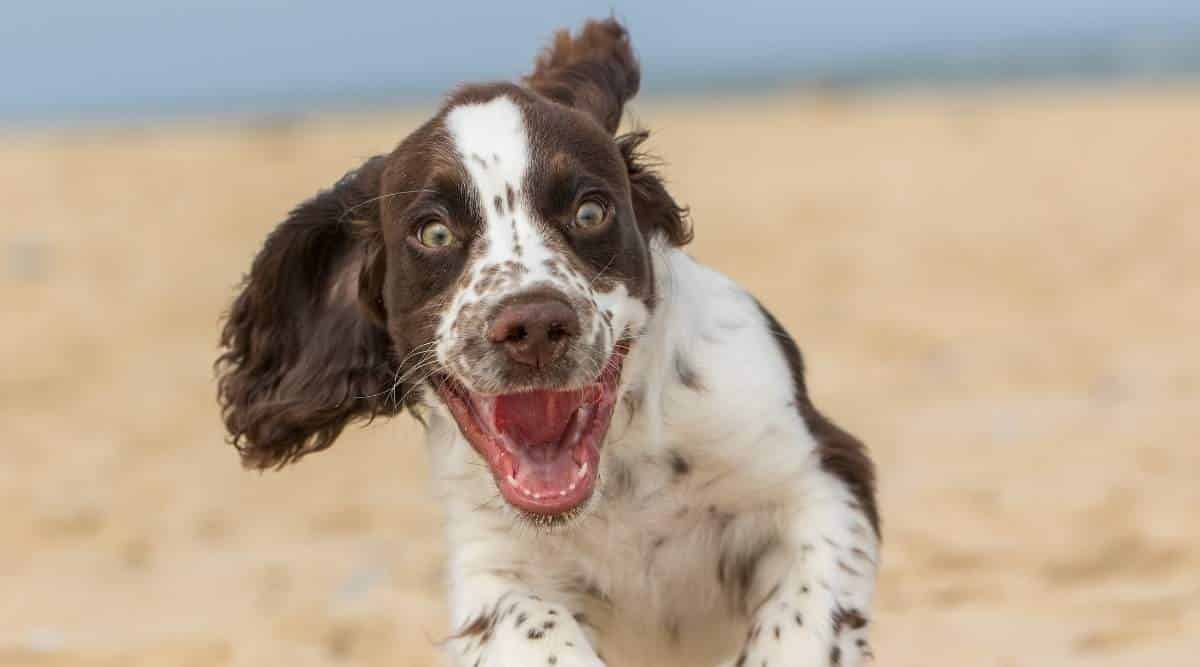Bloodhound Dog Breed Information: Facts, Traits, Pictures & More
When you purchase through links on our site, we may earn a commission. Here’s how it works.
The Bloodhound is a distinctive looking dog with a split personality. On the one hand, he is the most docile, calm, and nap-loving dog in the world. But once his nostrils have caught a scent, he transforms into an active, inquisitive, tenacious dog. And one who will stop at nothing until he has found whatever it is he is searching for.
If you are looking for a canine to assist you with searching, the Bloodhound is your dog. They make excellent hunting companions, and can also be extremely well-rounded family pets. But they also have some quirks to their lovable personalities and aren’t known for having the highest IQ.
In this breed guide, we look at all things Bloodhound. You’ll learn about his personality, grooming requirements, nutritional needs, and exercise requirements. You’ll also find out if he’s as stubborn as everyone makes him out to be(the short answer is, yes, he really is!) So, let’s jump into the world of the four-legged Sherlock Holmes!
Table of Contents
History

Bloodhounds, as we know them today, are thought to have originated from Europe around 1,000 years ago. But he might be more ancient than that! The third century saw a famous scholar describe a hound of unrivaled scenting abilities, intensely devoted to the scent. It is believed that he was describing the ancestors of the breed, the ultimate sniffing machine.
Perfected in western Europe, he was a product of the pre-reformation church. Packs of them were kept in monasteries and other noble households to hunt with their monks and masters. The monks tasked with developing the Bloodhound breed took it so seriously that the dogs were known as ‘blooded hounds’ because they were of noble blood. Not because they are hunting for blood, as many people first think.
Despite all of our technological advances today, no machine comes close to accurately scenting as his nose does. So much so, the Bloodhounds testimony of pursuing criminals and rescuing people is often used in court proceedings. It is thought that the breed was used to develop many other scenting breeds, such as the Black and Tan Coonhound.
It is not clear when the breed was first introduced to America. But legend has it that Benjamin Franklin inquired about possessing a pack of Bloodhounds to track down marauding Indians. He was recognized by the American Kennel Club (AKC) in 1885. Recently he has remained in the top 50 most popular dog breeds. He is commonly employed to search for missing people, but he is also found in loving family homes.
Temperament
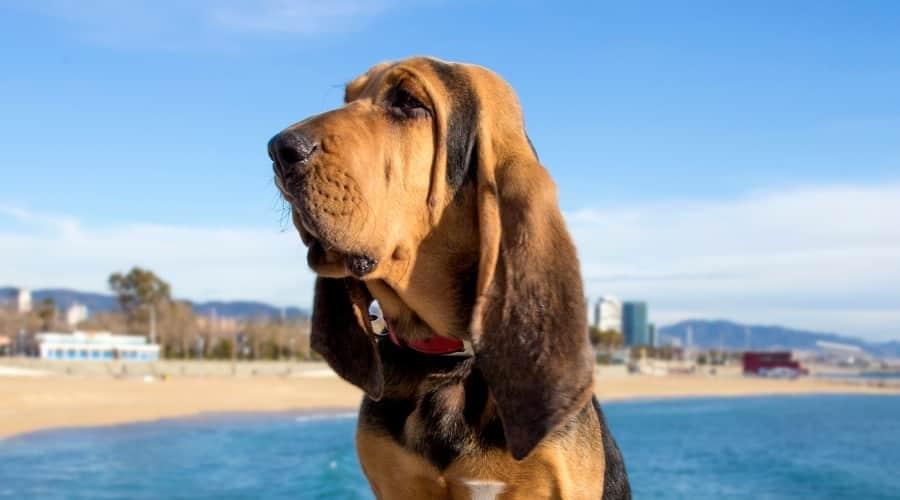
As we said, the Bloodhound has a split personality. So let’s take a look at what he is best known for first. And that, dear readers, is his incredibly powerful and talented nose. He has forever been tasked with finding criminals, missing people, and objects such as narcotics and money. But what does this mean for you? It means that his nose is forever getting him into trouble, and he is super inquisitive.
If you have the patience and time for his curious nose, you can be sure that you’re in for lots of fun and adventures. He might not be into highly impactive exercise, but he loves to explore. So if you’re looking for a ramble buddy, this breed is a great companion.
So, what about when his nose isn’t in action? Well, you’ll find him melted to the sofa with four paws to the sky. Snoring his long face off! This is why we describe him as a split personality doggo. Super lazy in the home and energetic outside. This is exactly why many families love him because he is the best of both worlds.
His lazy demeanor in the home means he is the prime suspect for cuddles and snuggles galore. And this boy will accept the attention with pleasure! He is very affectionate with his family and doesn’t bond with anyone in particular. Just whoever is more likely to give him unlimited belly rubs. He is slightly aloof with strangers at first, but he is quick to warm up if they show him attention.
He is an independent dog who is very laid back. As long as he gets his daily exercise and evening cuddles, he’s happy to spend time in his own company. His undemanding temperament is another big appeal of his for those who aren’t a fan of needy dogs. He is a happy go lucky hound until he catches a whiff of a squirrel!
Lastly, this hound is hellishly stubborn. So much that he might just be the most stubborn of them all. Don’t think that because he tracks criminals and rescues people, he will listen to you – he does all that by himself. He’s an independent dog who doesn’t need no owner! Or at least he thinks as much anyway. If you are after an independent dog, walk away right now.
Size & Appearance
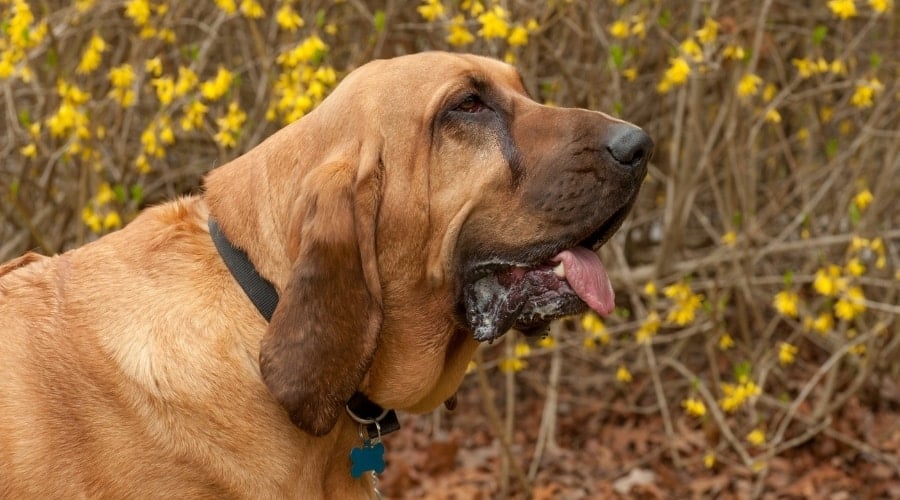
Bloodhounds are big dogs. A large to giant-sized one, in fact. He measures between 23 and 27 inches tall, and he weighs an impressive 80 to 110 pounds. Males tend to be larger than females. He is the largest of the hound group. The Bloodhound’s breed standard describes him as having a noble and dignified expression, characterized by power and wisdom.
His head is long but narrow, with a dome-shaped skull. Bloodhound ears are long, which reach all the way to thier neck and feel like velvet in your hands. His skin is soft, thin, and very loose, which hangs around his face and neck in deep folds. His eyes are deeply sunk into his skull and are diamond in shape thanks to his eyelids. The color of his eyes is brown or hazel in color, often matching his coat.
His thighs are thick and muscular, as are his paws. His tail is long but held high and curls up towards his head, but not touching his backline. When in scent mode, his tail hangs low to the ground as if to steer himself. His gait is powerful but swinging and free. Overall, his hound appearance is imposing yet friendly.
Coat & Colors
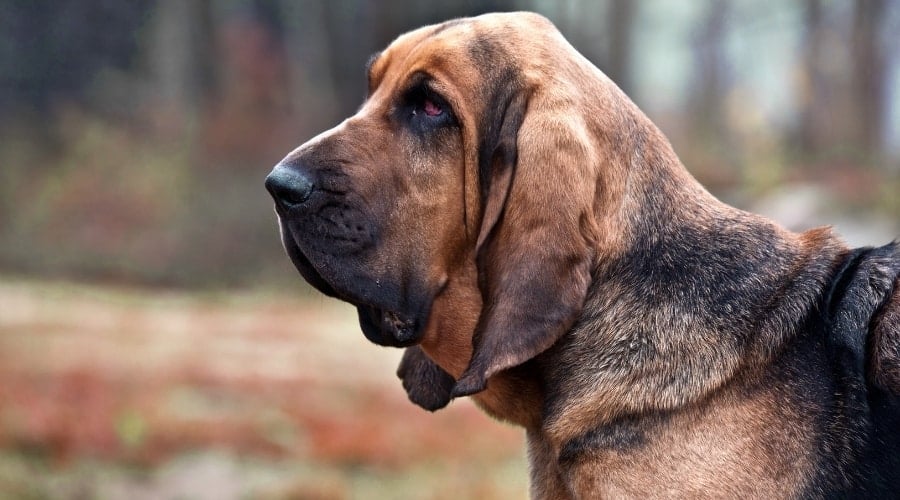
The Bloodhound has a short and dense coat. He sheds moderately throughout the year and a little heavier during the shedding seasons. His fur is straight, smooth, and silky to the touch. He only has three color options, and these are black and tan, liver and tan, and red.
His muzzle, tips of his ears, backline, and the end of his tail tend to be darker in color than the rest of his coat. Some Bloodhounds have a small amount of white flecked across their body or a small patch on their chest and feet.
Exercise Requirements
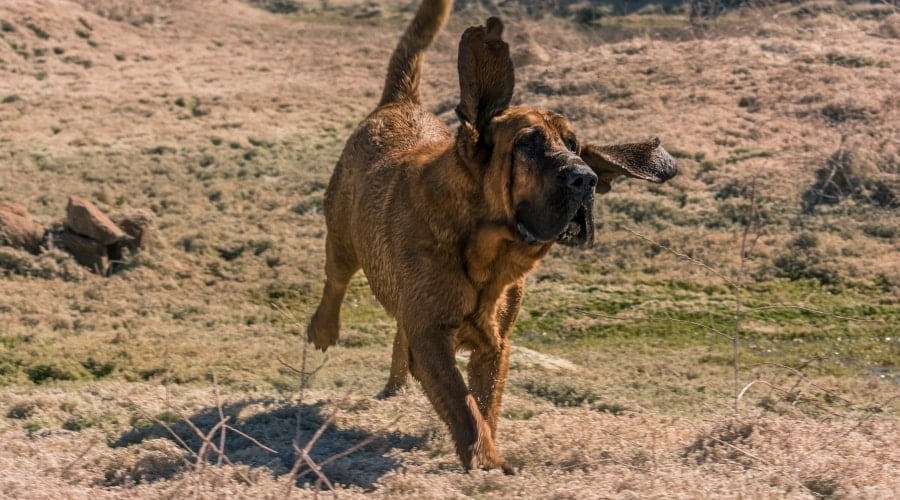
Despite cartoon depictions, they are energetic dogs that need at least 60 minutes of exercise every day. Although he is partial to a mid-afternoon snooze, he will become restless and frustrated without his exercise. He is not the most agile of canines and wouldn’t make a great jogging partner. But long adventurous walks with access to lots of smells would be his ideal activity. Woodland walkies will go down well.
He is of average intelligence, so don’t expect him to perform too many tricks or partake in doggy assault courses. And unlike most dog breeds, if there’s plenty of smells to be sniffed, he is content with long-distance walks most days without too much variation. And because he is a large breed, highly impactive exercise should be avoided. Especially during the first 18 months of his life.
A great activity for him to get his sniff on is at the local doggy park. It’ll also top up his socialization skills, mix things up, and he’ll make lots of friends too. As a pack dog, he’ll love the company and interaction. This leads us to multi-pet households. If he is socialized well, he would love to live with another dog or two (or three or four if you have the room). He is tolerant of other animals but probably won’t show much interest in them.
Bloodhounds love humans, including children. We would normally advise that large dogs are better suited to families with older children. But because he is so laid back in the home, it shouldn’t be an issue living with younger children. Just be sure to supervise them and watch out for that thick long swooping tail of his. He makes a loving family pet who adores humans of all ages and sizes.
Living Conditions
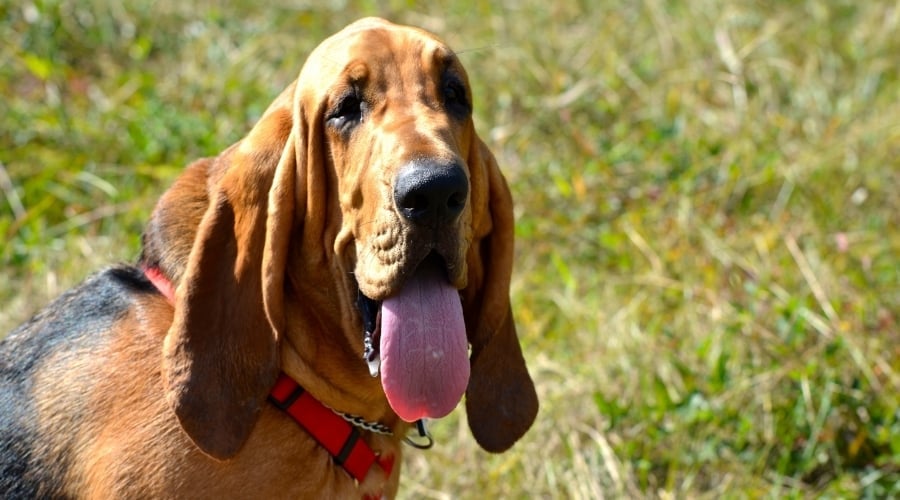
The Bloodhound needs a larger home with room to swing his tail about. He also needs access to a private and secure yard to top up his sniffing fix. It’s safe to say that apartment living is a big no-no. He is a country gent who loves the outdoors, but peace and quiet indoors.
The yard must be secured and Bloodhound-proof. His nose leads him to places that he shouldn’t go. And he will wander across 10 lanes of traffic if it means finding that scent. Keep him secure and safe, and be sure that this tenacious pup cannot dig his way out.
Training
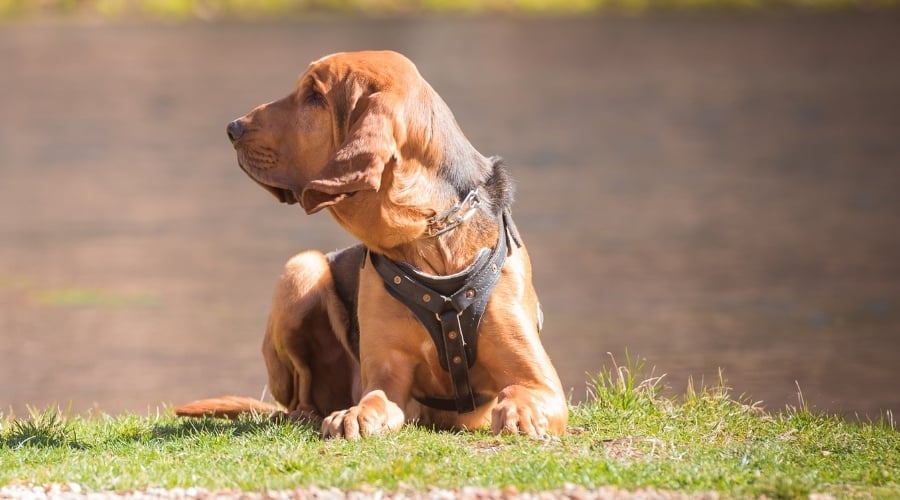
The Bloodhound is an extremely stubborn dog, and you have very little chance of turning him into an obedient pup. But, that doesn’t mean you shouldn’t try or instill basic commands. This is why we do not recommend the breed for first-time dog owners. Everything is done on Bloodhound time, and no one else’s. He can be frustrating at times, but this is all part of their charm. Patience, consistency, and skill are crucial.
To increase your chances of him learning commands or knowing who the real boss is, enroll him into a puppy obedience class. Do this as soon as you get him home. It will be fun for both of you, and he might just learn a thing or two. Positive reinforcement training is the most effective training method to use. He is likely to be motivated by food, so use this to your advantage.
Yes, the Bloodhound is a pack dog at heart, but he still needs to be socialized just like any other dog. Reputable breeders will start this process as soon as he is born, and it’ll be your job to continue this when you get him home. Introduce him to as many dogs as you can, and expose him to new environments, sights, and sounds.
Another training aspect to take up is leash training. His scenting tendencies mean that we would not advise letting this boy off the leash. And with 110 pounds at the end of a line, you need to teach him how to be a polite on the leash. If he is lunging for scents, it will not be a pleasant walk for either of you. His walker needs to be strong and be able to take charge should he try to follow his nose to places you don’t want to go.
Health
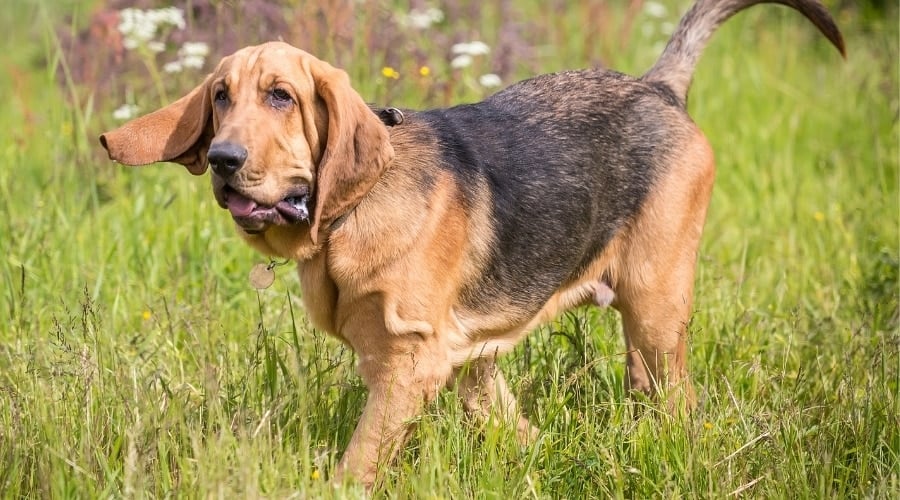
The Bloodhound is a relatively healthy dog breed, and he enjoys an average lifespan of 10 to 12 years. To maximize the chances of your pup being healthy, it’s crucial to work with a reputable breeder who will do everything they can to produce healthy puppies. Exercising him well, feeding him high-quality nutrition, and regular vet visits are important too.
The Bloodhound, like all other dog breeds, is prone to certain health concerns more than others. While you cannot discount other health conditions, the below are the most common in the breed. Always work with a breeder who can produce health certificates for some of the following concerns:
Hip and Elbow Dysplasia
Dysplasia of the hip and elbow joints is common in large dog breeds. The bones grow at a much quicker rate than small dogs, and as such, it can grow unevenly. This uneven growth, combined with the heavy weight, means more joint grinding. Mobility issues, pain, and eventual arthritis are likely to occur in later life due to these concerns. Look out for symptoms, including limb stiffness, lameness, and difficulty standing up or climbing the stairs.
Eye Conditions
The breed is prone to various eye concerns, with ectropion and entropion being the two most common. This is the rolling outwards or inwards of the eyelids, leading to increased eye infections and soreness. As soon as you notice any redness, overitching, excess drainage, or dry eyes, take him to the vet for a checkup to prevent infections and seek treatment.
Cardiac Concerns
Heart disease is an increasing problem for this breed. Cardiomyopathy is a heart disease, which makes it harder for it to pump blood around his body. It can result in heart failure if left untreated.
Skinfold Dermatitis
The Bloodhound’s loose skin and folds are the perfect breeding ground for bacteria and infections. Thanks to trapped moisture and warmth. A good grooming routine and regular cleaning of the folds is the best way to prevent this. But ongoing infections may need surgery to remove the folds.
Nutrition
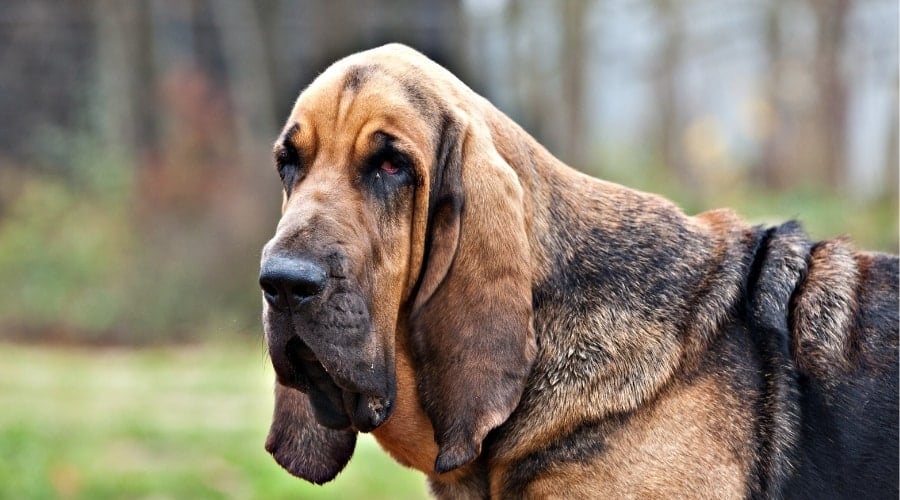
The Bloodhound is a large to giant-sized dog who eats a lot of food! Depending on his age, size, and energy levels, he’ll consume between four to eight cups of food every day. Be sure to split this into at least two different meal sittings because the breed is at risk of bloat. Bloat is a life-threatening condition that usually occurs during mealtime. Especially if it’s immediately before or after exercise. Be sure to research it and learn about the symptoms and what to do if this happens.
It is important to feed him a large breed puppy kibble during puppyhood. These contain the optimum ratios of calcium, phosphorus, fats, and vitamin D to stabilize his rapid bone growth. This will decrease the chances of him developing bone and other skeletal diseases such as joint dysplasia. When he reaches adulthood, switch him to a large breed adult kibble.
Always feed your Bloodhound the best quality food that you can afford. A high-quality kibble from a well-known brand will provide a balanced diet. A balanced diet includes meat proteins, healthy carbohydrates, fiber, omega fatty acids, vitamins, and minerals. Omega fatty acids are crucial for his skin, cardiac health, and joints.
Grooming
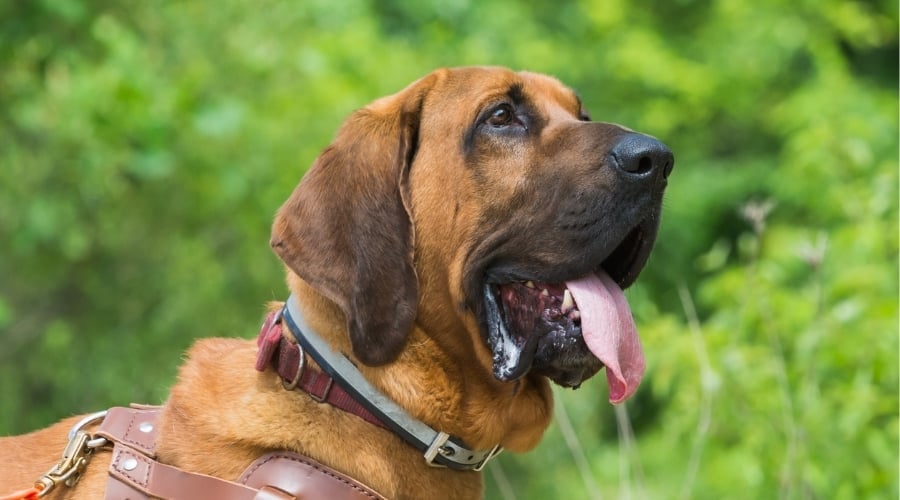
The Bloodhound has a dense coat that is shiny and sleek. It is straight and easy to groom. He sheds moderately throughout the year, so you should brush him once a week to manage his shedding. He sheds a little heavier during the shedding seasons, so you might want to increase his brushing to twice a week. A rubber hound mitt is the best brush to use during grooming sessions. Remember, his skin is thin and loose, so be careful using pin brushes.
The Bloodhound needs bathing once every eight weeks or so. He is a relatively clean dog. However, he is known to have a musty doggy odor. This is why owners opt to use deodorizing dry doggy shampoo or doggy wipes to freshen them up in between baths. Use a soothing and natural shampoo that will be gentle on his skin, such as oatmeal doggy shampoos.
Because the breed is well known for loose rolls of skin, he is prone to skinfold dermatitis and other skin infections. With a clean damp cloth or specific doggy skinfold products, wipe in between each fold every day to remove sweat, dirt, and bacteria. This is a crucial part of his grooming. And without regular cleaning, it will lead to sore spots, infections, and bad odor.
Be sure to clean his long ears weekly with doggy ear cleaning products or a warm damp cloth. His long ears are another breeding ground for bacteria, so it’s important to keep on top of bacteria. Brush his teeth weekly to avoid the build-up of plaque and resulting periodontal diseases. His nails will need trimming monthly, or more often if they do not wear down naturally on his long walks.
In addition to his strong doggy odor, there is something else to mention. And it is often a sticking point for many dog owners out there (literally!) The Bloodhound is a dribbly doggo who has forever got drool hanging from his chops. If you aren’t a fan of drooly dogs, you should likely consider a different breed. And if you don’t mind it, be sure to keep wet wipes handy.
Breeders & Puppy Costs
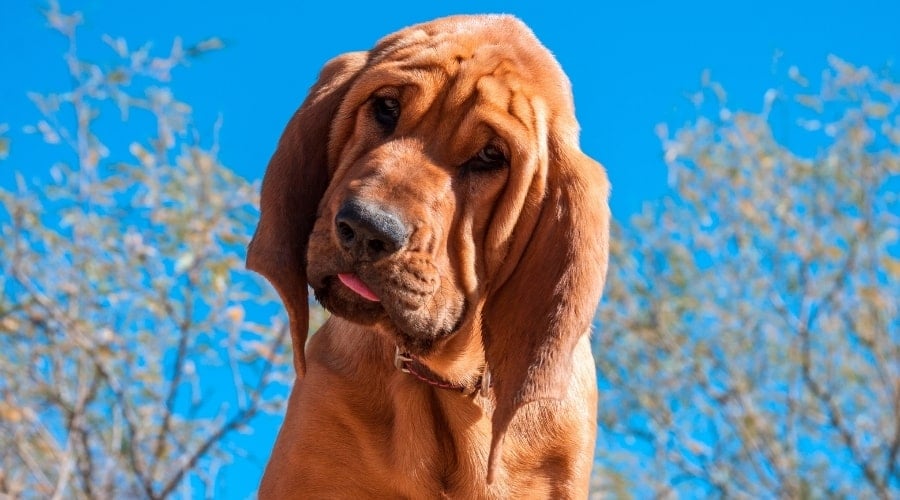
Bloodhounds aren’t the most common dog breed, so expect to travel to find a reputable breeder. Also, expect there to be a waiting list for new puppies, but don’t worry, this is a sign of a good breeder. The average price of a puppy from a good-quality breeder is around $1,200. This can be more expensive if you are looking for a puppy from an award-winning lineage.
Reputable breeders will breed healthy dogs and screen for health concerns. They will raise their pups with love and socialize them, meaning that you are more likely to take home a polite pup too. Always meet the mother and the puppies in person, and ask them lots of questions to know you are prepared for life with a stubborn Bloodhound.
Avoid puppy mills and bad breeders at all costs. Look out for signs of bad breeding, such as ill puppies and dirty conditions. If they pressure you into a sale or ask to meet at a parking lot or somewhere similar, walk away. A great place to start your search for reputable breeders is with the AKC’s list of Bloodhound breeders and their available puppies.
A Bloodhound puppy isn’t just for Christmas; he is for an average of 10 to 12 Christmases. So, you need to think about the ongoing costs of looking after a giant dog, because they are not cheap. Lots of food, large crates, coats, and indestructible toys all come at a cost, as does doggy insurance.
Rescues & Shelters
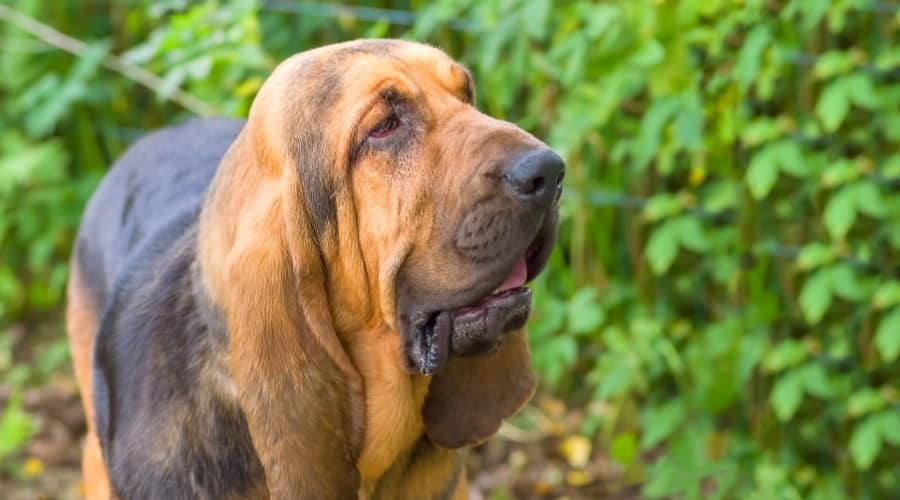
Buying a brand new pup from a breeder is not your only option here. With so many dogs looking for their forever homes across America, why not consider adopting from a rescue or shelter? Head out to your local rescue shelters, and speak to the staff about current Bloodhound residents. They might not have one at the time of your visit, but they may know of an available dog at another shelter.
Alternatively, there are many breed dedicated shelters that focus all of their efforts on rehoming Bloodhounds. A great place to start is with the American Bloodhound Club who lists several Bloodhound rescues, along with contact details and other useful information.
As Family Pets
- The Bloodhound is a very stubborn dog.
- He should only live with an experienced family.
- He loves his family and is very affectionate.
- Bloodhounds need about 60 minutes of daily exercise.
- They can also be lazy after exercise, preferring late afternoon naps.
- He is quick to warm up to guests.
- Because of his independence, he doesn’t typically suffer from separation anxiety.
- Bloodhounds are an independent dog that have a strong sense of smell.
- He will tend to follow that more than your command.
- He needs a large family home and access to a secured yard.
- The Bloodhound can live with children and other dogs.
- He is very laid back and makes a great family pet.
Final Thoughts
The Bloodhound is a super stubborn dog who would frustrate many people. But for those with the experience, patience, and know-how, he makes a charming canine companion. He is both energetic and lots of fun, but also really laid back in the home. Making him a well-balanced dog that isn’t too needy or dependent on his humans.
As long as you have the patience for his training, a large home, and time for lots of long-distance walkies, you and the Bloodhound are sure to get along well. And if you’re forever losing your keys or your phone, why not train this super sniffing machine to find them for you? He might not be for everyone or every family, but he is the apple of many dog lovers’ eyes out there, and for good reason.



